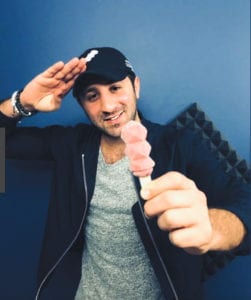Alumnus reimagines frozen snacking through healthy, design-driven treats

Entrepreneurs commonly have business leaders they aspire to be like. For David Greenfeld, BS 13, it’s Willy Wonka.
Greenfeld is co-founder of Dream Pops, a plant-based ice cream company whose unique, geometric frozen pops look like nothing you’ve eaten before. With the tagline, “Anything is Popsicle,” Dream Pops has already amassed a social media following of customers celebrating clean eating.

“Our goal is to be the Willy Wonka of plant-based confections,” Greenfeld says. “We plan on replicating the childhood nostalgia associated with Popsicles and ice cream bars and replacing them with healthier alternatives that are plant-based and fueled with superfoods.”
Indeed, Greenfeld is positioning his ice cream bars to totally transform the frozen treat category—in design, ingredients, marketing, and delivery.
Dream Pops are less than 100 calories each with formulations created by three-star Michelin chef Juan Amador. The gluten-, dairy-, and soy-free pops contain coconut milk and ingredients like ceremonial matcha, lion’s mane mushroom, baobab, and cacao. They’re sweetened with less than five grams of coconut sugar.
It’s a way to make a mark in an industry that’s seen only moderate innovation, the most recent being high-protein ice cream, like Halo Top, sweetened largely with sugar alcohols that allow for entire-pint indulgence.
“We believe the next wave of ice cream innovation will be snackable, portion-controlled, and plant-based offerings fueled by superfoods and adaptogens,” Greenfeld says.
I think food and beverage brands, or more importantly, all brands, are now content companies. We’re creating 500 to 1,000-plus pieces of original content a year. I’d love to double, triple, or quadruple that.
Design—in particular 3D printing—is Dream Pops’ most recognizable innovation. Initially Greenfeld focused on B2B, producing customized pops for individual brands, like 2017’s frozen pop for Beats by Dr. Dre, the maker of high-end headphones, for a marketing campaign at the Coachella music and arts festival. Because the pops are shaped in molds formed by a 3D printer, they’re infinitely customizable. But Greenfeld and his partners soon realized that constantly churning out new molds would be cost prohibitive.
Instead they decided to focus primarily on consumers, staying with their original geometric shape—a patented design—and building a brand around that. “That shape is our logo, our Nike swoosh. We believe it is the modern embodiment of ice cream for the next generation,” says Greenfeld.
Dream Pops’ iconic, eye-catching design makes them Instagram-ready, and that channel has in fact been the company’s top marketing platform. “I think food and beverage brands, or more importantly, all brands, are now content companies,” Greenfeld says. “We’re creating 500 to 1,000-plus pieces of original content a year. I’d love to double, triple, or quadruple that. A lot of consumers like to Instagram our product and interact with it digitally. So on our sticks, we have QR codes and calls to action.”
Last year Dream Pops began selling to customers directly from their website—one of the first companies to offer ice cream affordably online. But grocery stores like Whole Foods, Bristol Farms, and Fairway Market represent the biggest growth for Dream Pops. Greenfeld expects to be in 1,000 stores by year’s end. The company is also first to market with vertical freezers offering single-serve ice cream at checkout.
Pop-ups and collaborations with other companies remain a big part of their business, in part because Dream Pops is a nimble, quick business, despite being a small team of around ten. “We have our own factory, a flavor house, a food scientist, and an R&D facility that can turn around a new flavor in three weeks, and a custom product in about five,” Greenfeld says.